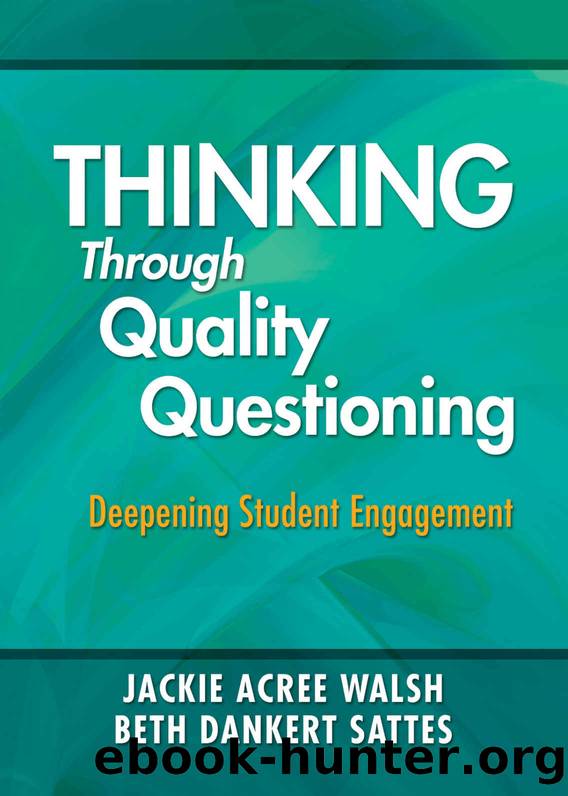Thinking Through Quality Questioning by Jackie A. Walsh & Elizabeth D. Sattes

Author:Jackie A. Walsh & Elizabeth D. Sattes [Walsh, Jackie A.]
Language: eng
Format: azw3
Publisher: SAGE Publications
Published: 2011-06-29T00:00:00+00:00
Tailor Feedback to Match the Cognitive Level of the Question
Appropriate feedback varies depending upon the complexity and the cognitive level of the question posed. As previously argued, the assessment of a student answer to identify learning gaps and the subsequent provision of feedback is a complex cognitive task. In fact, this is the aspect of quality questioning that we personally find to be most challenging. Most of us are fairly skilled in assessing the correctness of the knowledge component of a student's answer. Hence, we are able to provide feedback to remember-level questions quickly and with relative ease. We are also able to identify knowledge gaps within higher-level questions. The real test is to offer on-the-spot feedback that focuses on the cognitive processing dimension of student responses. This is a higher-level skill for teachers, one that requires both preparation and practice.
As shown in Figure 4.4, when students are asked to respond to basic remember questions that request simple recall of facts, teachers react with an assessment as to whether the response is correct or incorrect. At the understand and apply levels, appropriate feedback is indirect; it asks students to explain their thinking and how they arrived at their answer. At the highest cognitive levels (analyze, evaluate, and create), teachers should provide feedback on the knowledge dimension but focus on student thinking. At these levels, many answers are possible, so the teacher is not looking for one correct answer. If the thinking has led the student to an incorrect answer, however, the teacher should guide the student to a correct answer.
Download
This site does not store any files on its server. We only index and link to content provided by other sites. Please contact the content providers to delete copyright contents if any and email us, we'll remove relevant links or contents immediately.
Artificial intelligence-aided wind plant optimization for nationwide evaluation of land use and economic benefits of wake steering by Dylan Harrison-Atlas & Andrew Glaws & Ryan N. King & Eric Lantz(97)
The Pedagogy of Real Talk by Paul Hernandez(87)
Thinking Through Quality Questioning by Jackie A. Walsh & Elizabeth D. Sattes(85)
The Politics of Education: Culture, Power, and Liberation by Paulo Freire(76)
Cell-surface area codes: mobile-element related gene switches generate precise and heritable cell-surface displays of address molecules that are used for constructing embryos by Unknown(56)
Understanding Community Colleges by John S. Levin(54)
Mindfulness in Multicultural Education: Critical Race Feminist Perspectives by Kathryn Esther McIntosh(54)
School Leaders Matter: Preventing Burnout, Managing Stress, and Improving Wellbeing by Helen Kelly(52)
The Development of VisibleLight Photoredox Catalysis in Flow by Unknown(52)
DendrimerEncapsulated Cobalt Nanoparticles as HighPerformance Catalysts for the Hydrolysis of Ammonia Borane by Unknown(51)
Kids Driving Me Crazy by Unknown(51)
How to Engage in Difficult Conversations on Identity, Race, and Politics in Higher Education: A Practical Guide for Faculty by Tammy Hodo Jacques Whitfield Brian Van Brunt Poppy Fitch(49)
Predicting pyrogenic organic matter mineralization from its initial properties and implications for carbon management by Thea Whitman & Kelly Hanley & Akio Enders & Johannes Lehmann(45)
Innovations in Interdisciplinary Teaching by Carolyn Haynes; Association for Integrative Studies(43)
Cocrystallization-like strategy for the codelivery of hydrophobic and hydrophilic drugs in a single carrier material formulation by Yi Li & Chao Teng & Helena S. Azevedo & Lifang Yin & Wei He(43)
Alignment of linear polymeric grains for highly stable N-type thin-film transistors by unknow(40)
Layered polyoxovanadate V15: from structure to highly anisotropic magnetism by Boris Tsukerblat & Alex Tarantul & Sergey Aldoshin & Andrew Palii(40)
Developing Intercultural Competence in Higher Education: International Studentsâ Stories and Self-Reflection by Lily A. Arasaratnam-Smith Darla K. Deardorff(38)
Criteria for consideration in the accreditation of culture collections participating in MINE, the Microbial Information Network Europe by Unknown(32)
